[dropshadowbox align=”none” effect=”lifted-both” width=”850px” height=”” background_color=”#ffffff” border_width=”1″ border_color=”#dddddd” ]Gabriele Aroni (b.1985) is a Lecturer at the School of Interior Design at Ryerson University, Toronto, Canada <gabriele.aroni@ryerson.ca>. He holds an M.Arch from the University of Florence, Italy and an MSc in Digital Media Production from Oxford Brookes University, UK. His research interests include architectural history, semiotics of architecture and design, multimedia technology and interactive media especially in relation to cultural heritage.[/dropshadowbox]
Abstract
The purpose of this article is to apply the Threefold Laws of Meaning, developed by Lady Welby, to the Corinthian order of the Basilica of San Lorenzo in Florence so as to analyze the morphological differences and symbols of its architectural order from 1420, when the construction of the new plan for the Basilica commissioned by Giovanni di Averardo dei Medici and designed by Brunelleschi started, to 1490, when it came to its completion under Lorenzo de Medici and the supervision of Giuliano da Sangallo. It will demonstrate how Lady Welby’s threefold laws of meaning can be successfully used to comprehend, through signs, the historical evolution of the Basilica and the transformation of architectural thought in the 15th century.
Keywords: Brunelleschi; Renaissance; Classical Order; Corinthian; Basilica of San Lorenzo; Victoria Welby
Gabriele Aroni: Ryerson University. E-mail: gabriele.aroni@ryerson.ca
Introduction: architecture as a semantic art
Architecture might be regarded as an asemantic and non-representative art, as its aim is not to reproduce something that already exists but to create something new. In addition, architectural objects apparently do not communicate but rather function (Eco 1997, 173-195), as they primarily serve to fulfill a structural or mechanical role. It is unequivocal that a roof serves to cover and a column to hold that roof and prevent it from falling. This idea of a lack of communicative function in architecture has been strengthened by Modern architectural works – especially apartment buildings, factories, hospitals, etc. – that are said not to have any semantic and/or symbolic functions. Spectators of architectural works are thus not used to looking for meanings other than the formal qualities of the work. (Wallis 1973, 220-238; Munro 1987, 115-128) However, it has been proven that in many periods and in many culture areas, constructions, above all temples and palaces, used to be conceived as ‘signs’ or ‘symbols’, and were thus semantic or symbolic in nature (Wittkower 1988) and bearers of meanings, understandable not only by the people, such as architects and scholars, who possessed the necessary knowledge to interpret and ‘read’ them, but also by the general public who came in contact with these buildings. Vitruvius, in the only surviving architectural treaty of the ancient western world, the De Architectura, writes: “cum in omnibus enim rebus, tum maxime etiam in architectura haec duo insunt, quod significatur et quod significat.” [In all matters, but particularly in architecture, there are these two points, the thing signified, and that which gives it its significance]. (Vitruvius 2003) This is particularly true in the case of the classical orders, in which every part and moulding of the composition has a phytomorphic or xylomorphic origin, usually referring to the original wooden structure of ancient constructions. Yet, as shall be examined in greater detail further on, these compositions often bear other meanings.
The Basilica of San Lorenzo and the beginning of the Renaissance
The object of the analysis is the Corinthian order of the Basilica of San Lorenzo in Florence, Italy. First consecrated in 393 CE, this church went under a program of heavy additions and enlargements that started in the first decades of the 15th century and lasted well after the beginning of the following century. (Morolli and Ruschi 1993) It is worth focusing on the decades comprised between 1420 and 1490 (fig.1), as this timeframe gives a very interesting overview of the changes that occurred during the transition between the Gothic and Renaissance periods. This is visible in terms not only of the style and aesthetics of the architectural order, but also in the symbols and meanings of its various parts, which evolve from medieval symbols to the more classical icons of the Renaissance.
The plan for the ‘new’ Basilica of San Lorenzo was started by Giovanni di Averardo dei Medici when he commissioned the building of the family chapel and the new sacristy (fig.2) – the one that will later be known as the Old Sacristy, since Giuliano da Sangallo will erect a new one around 1485, later decorated with the famous Michelangelo sculptures in 1519 – to Filippo Brunelleschi in 1421. Brunelleschi was born in 1377 (Manetti 1976 [1490]) and thus educated as an architect in the late-medieval Florentine school, with buildings such as the Gothic Santa Maria del Fiore, Santa Trinita and Santa Croce. At the same time, Brunelleschi probably knew at least part of the Vitruvian text – the De Architectura – that had been circulating in Florence since the end of the 14th century (Bruschi and Miarelli Mariani 1980, 389-415) and he also made several trips to Rome (Vasari 2005 [1550]), where he “vide el modo di murare degli antichi” [saw the way the ancients were wont to build]. (Manetti 1976 [1490]) This duplicity in Brunelleschi’s background meant that he was influenced by both Gothic and classical architecture; the result is a ‘hybrid’ language containing elements of Florentine vernacular architecture as well as Gothic and classical architecture that denote the transition to the newly rediscovered classical architecture which will reach full blossom with the High Renaissance. This fact is of particular interest, as analyzing the architectural order created by Brunelleschi – such as the one in the Basilica of San Lorenzo that we are going to see in detail – is a well-suited case to undertake with semiotic tools such as the Threefold Laws of Meaning of Victoria Lady Welby.
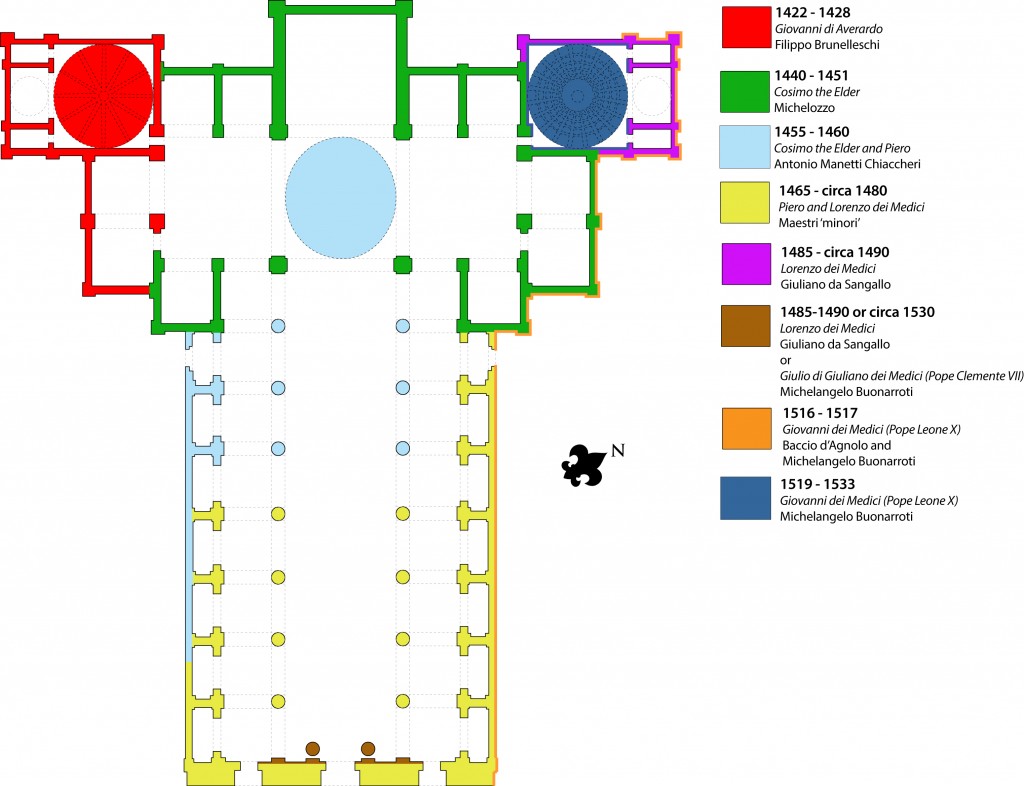
Fig. 1: Chronology of the Basilica of San Lorenzo
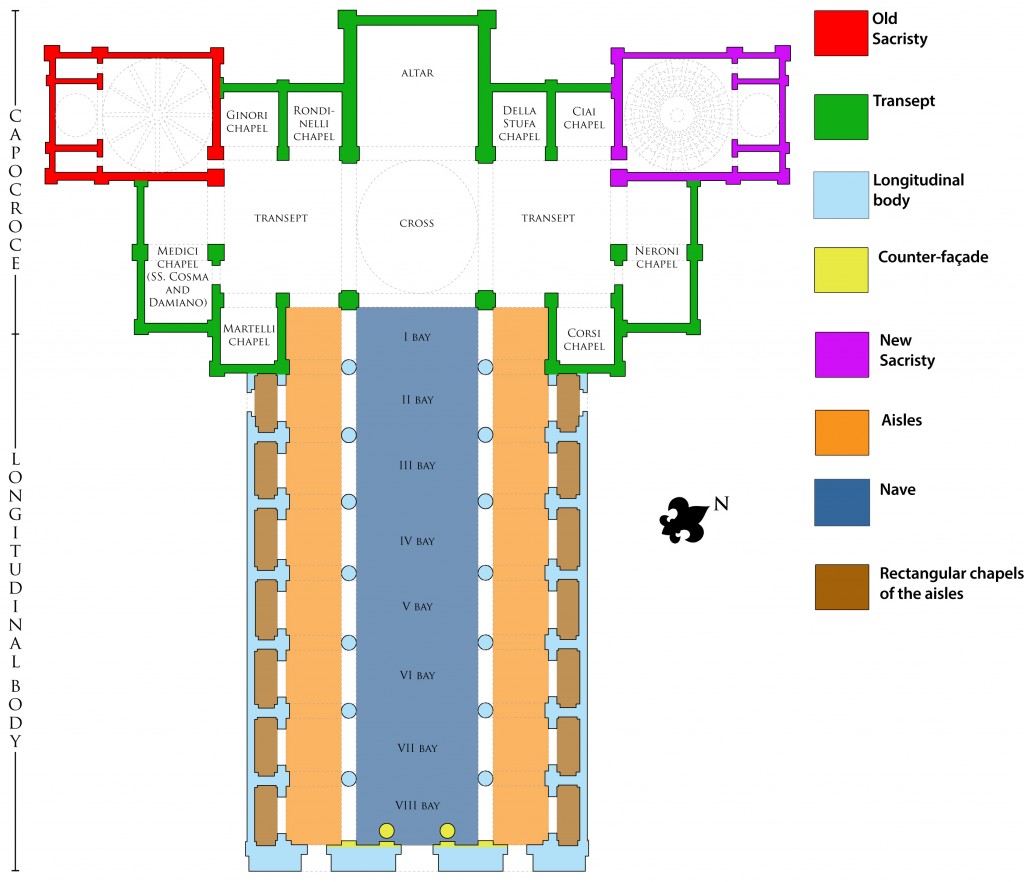
Fig. 2: Plan of the Basilica of San Lorenzo
The Threefold Laws of Meaning
Victoria Welby elaborated the Threefold Laws of Meaning in her research regarding sign and meaning. She coined the term significs that was introduced in her 1896 essay ‘Sense, Meaning and Interpretation’ (Petrilli 2009) to appropriately ‘denominate an approach that focused on meaning from the perspective of its interconnection with value’. (2009: 255) The term encompasses not only the study of language, but also all the means of human expression, as the Dutch significian Jacob Israël de Haan explained in an article written on the occasion of Welby’s death in 1912:
Language is not the only means of human expression and significs therefore encompasses more than the philosophy of language: the philosophy of expression. For the students of significs, the other means of expression are also of interest: music, painting, sculpture, chemical and mathematical formulas, geometric figures, gestures. (de Haan in Petrilli 2009: 256)
It is not hard to add architecture to the list, especially considering the presence of sculpture and geometric figures, both essential components of the classical order. Welby divided meaning into three levels: sense, meaning and significance: “the one crucial question in all Expression, whether by action or sound, symbol or picture, is its special property, first of Sense, that in which it is used, then of Meaning as the intention of the user, and, most far-reaching and momentous of all, of implication, of ultimate Significance”. (Welby in Petrilli 2009: 255)
Sense
Sense constitutes the first level of meaning and might be interpreted in various ways: “The term ‘sense’ has different meanings: these vary from reference to the world of the senses understood in biological terms, the world of sensual perception, perceptual experience, to the properly human world of significance and its connection with values, ideology, and social programs” (Petrilli 2009: 264). This definition might bring about different interpretations in architecture, as every architectural artefact is a physical structure, before being a medium bearer of any meaning. The question of where to start defining the architectural object, is therefore posed: 1) should it be examined from a mere perceptual and sensorial point of view – a column being, for example, several carved blocks of stone, of a certain colour and of certain dimensions – or 2) should one discard this step as not semantically relevant and assume that, for example, several blocks of carved stones arranged to form a vertical structure can be immediately identified by the interpretant as a column. Following the second interpretation of ‘sense’, the first level of the meaning triad is already on an architectural level, and the analyzed object is thus considered and acknowledged as a construct that bears a meaning. For my analysis of the classical order, I will consider the ‘second’ level and define the objects with their architectural properties.
Meaning
Meaning is the second level of the triad and it expresses the intent behind the existence of the sign as Welby remarks in her essay ‘What is Meaning?’ (1903): “The meaning of a word is the intent which it is desired to convey – the intention of the user.” (Welby in Petrilli 2009: 264) We must note how every architectural object bears a twofold meaning: a functional and a communicative one. The intention of the architect for placing a specific architectural construct, a sign, in a specific location is dictated not only by the needs of communication, but also by structural and functional needs. Therefore, the communicative meaning of the artefact is another type of functionality, as important as the functional one, which might be understood and defined better from a semiotic point of view. (Norberg-Schulz 1968) In this article, I will focus mainly on the communicative aspect of the architectural order, as it is the most semiotically relevant. However, a reference to the functional aspect of the architectural order is often necessary and intertwined with its communicative part, and thus will also be considered at times.
Significance
Significance might be considered the final result of the sign, the “overall effect, import and value of signifying process.” (Petrilli 2009: 264) It is how the sign is actually read by the interpretants, in relation to the context: “The Significance is always manifold, and intensifies its sense as well as its meaning, by expressing its importance, its appeal to us, its moment for us, its emotional force, its ideal value, its moral aspects, its universal or at least social range”. (Welby in Petrilli 2009: 264) In architecture it is thus how the sign is perceived by the interpretants, how it is deciphered and what it communicates. This can vary based on several social and historical factors, and if the sign under analysis was created for a different (be it historically, demographically or other) public, it should be re-contextualized in order to understand how the message was perceived by the people who were meant to receive it. It is nevertheless of interest to study how the same sign can be prone to be interpreted in different ways and how the significance can change.
The Corinthian order
The architectural order that Brunelleschi-and the architects who succeeded him-uses in the Basilica of San Lorenzo is the Corinthian (fig.3), the most slender and ornate of the five orders. He follows the general rules of the classical Corinthian, despite applying notable modifications in terms of both proportions and morphology. (fig.4)
To understand the meaning of the Corinthian order it is important to know its origin, as the morphology and proportions, and thus the symbolic meaning of the order often refer either to the mythical inception of the order, or the ancient wooden structures in which, presumably, it was used at first. The oldest account we have of the origin of the Corinthian order is in Vitruvius’ De Architectura, where he explains, in the fourth book, how a young maiden died of an illness in the city of Corinth and then a basket containing objects dear to her was placed on the tomb and covered with a roof tile. The basket happened to be on top of an acanthus root, whose leaves sprang along the basket and bent on the top, pressed by the weight of the tile, to form helices. The architect Callimachus, passing by and struck by the sight, decided to create an architectural order inspired by it. (Vitruvius 2003) The Corinthian capital, in fact, is constituted by three tiers of leaves around a ‘basket’-which we will call ‘bell’-and four helices, with a flat ‘tile’, called abacus, on top.
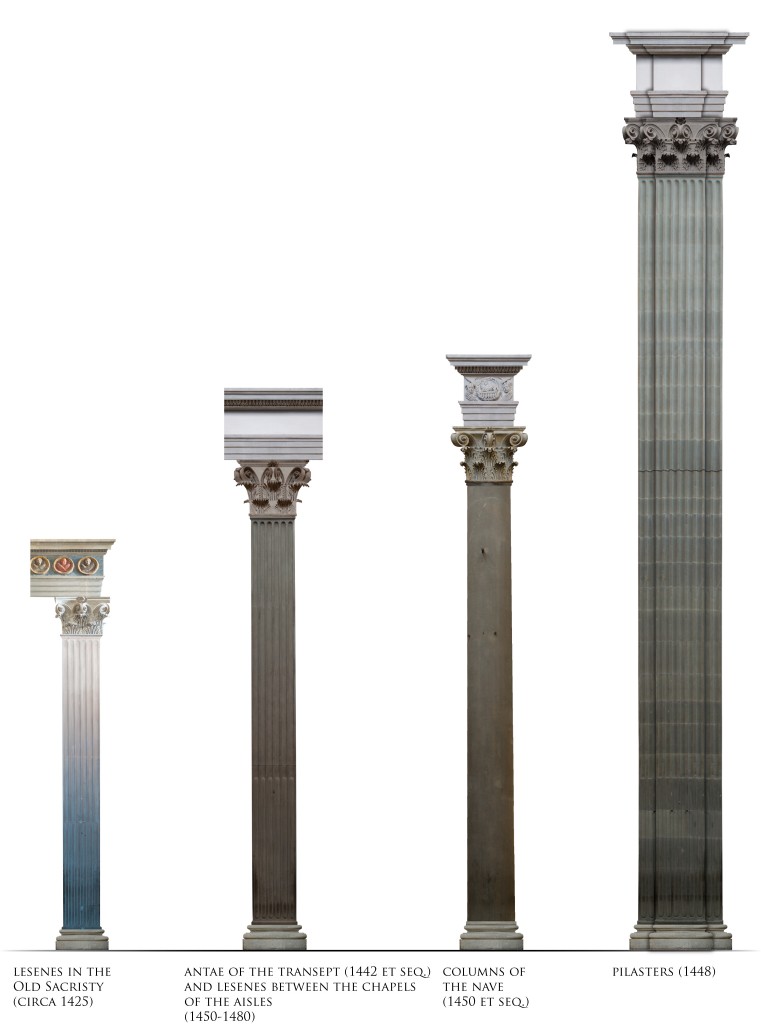
Fig. 3: The Corinthian orders in the Basilica of San Lorenzo in Florence
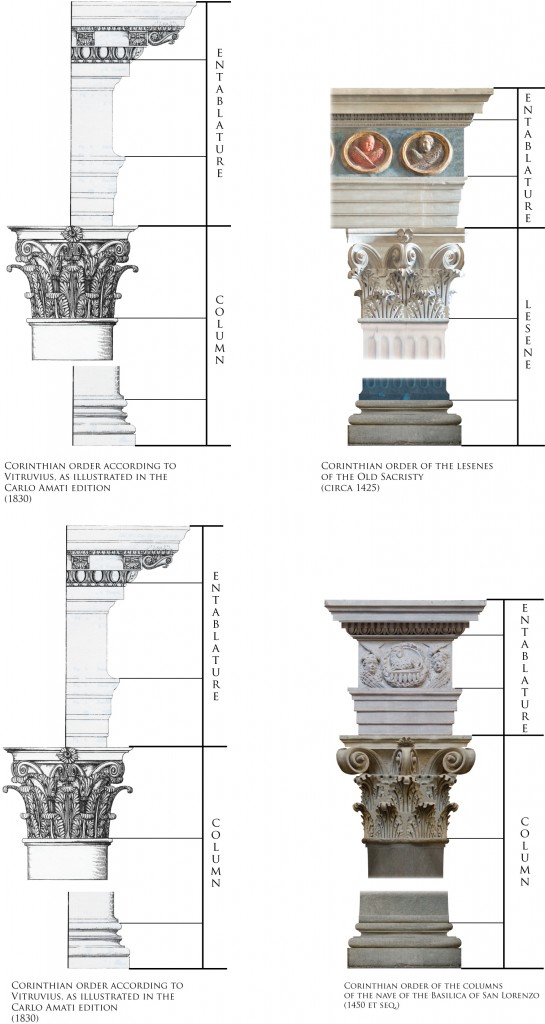
Fig. 4: Comparison of the Corinthian order from the treaty of Vitruvius (Morolli 1988) with the Corinthian order in the Basilica of San Lorenzo in Florence
1422-1428 The Old Sacristy and the Medici Chapel
The construction of the ‘new’ Basilica of San Lorenzo started with the addition of the Old Sacristy and the Medici Chapel, the only part of the church in which Filippo Brunelleschi personally took part. This is noticeable in the style and proportions of the architectural order, a hybrid Corinthian that draws its inspiration from both the classical architecture of Vitruvius’ De Architectura, and the Gothic and Romanesque architecture of medieval Florence. In the Old Sacristy, Brunelleschi sets the order that will be, with several variations, followed by his successors. Analyzing it with the Threefold Laws of Meaning of Victoria Welby will help in determining the peculiarities of this Corinthian order and explaining the choices of the architect who conceived it.
Sense
The architectural constructs in the Old Sacristy and Medici Chapel can be quickly identified as a classical order – the structure is composed of lesenes and entablatures – despite the lack of the pedestal. (fig.4) The lesenes can be canonically tripartite in base, shaft and capital as it is common to all the architectural orders and the entablature shows the main components of the classical order, visibly divided into three members: architrave, frieze and cornice. (fig.5) The architectural order is the Corinthian: this can be deduced primarily from the style of the capital (fig.6) that shows the presence of leaves and helices, (fig.7) but also from the decorated continuous frieze in the entablature. The proportions are also the ones handed down from the classical tradition, as the ratio between the width of the lesene and its height is 1:9,5 – close to the 1:10 that we can find in the Vitruvian text.
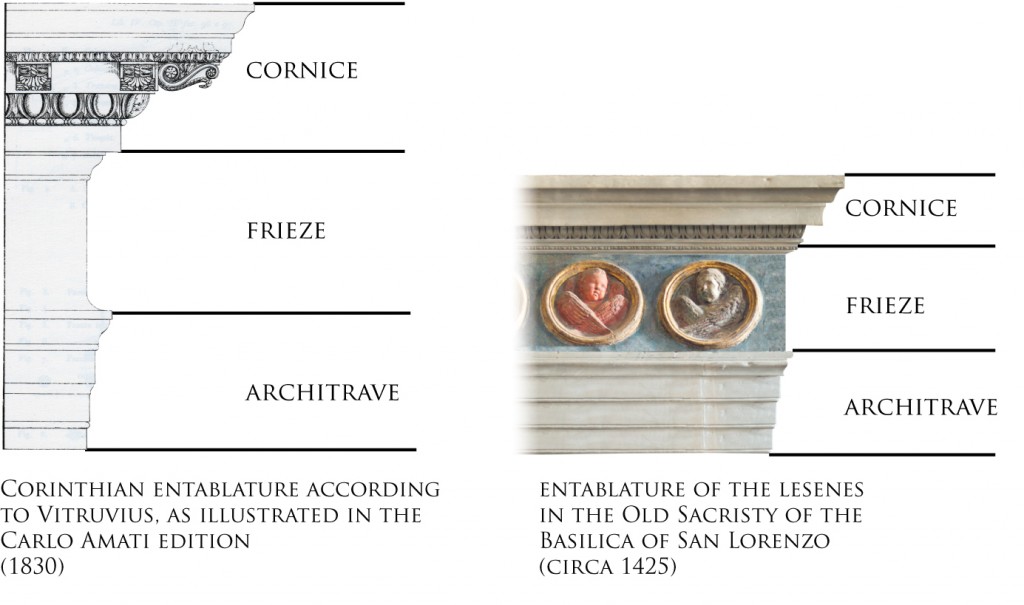
Fig. 5: Comparison of the Corinthian entablature illustrated in the treaty of Vitruvius (Morolli 1988) with the entablature in the Old Sacristy in the Basilica of San Lorenzo
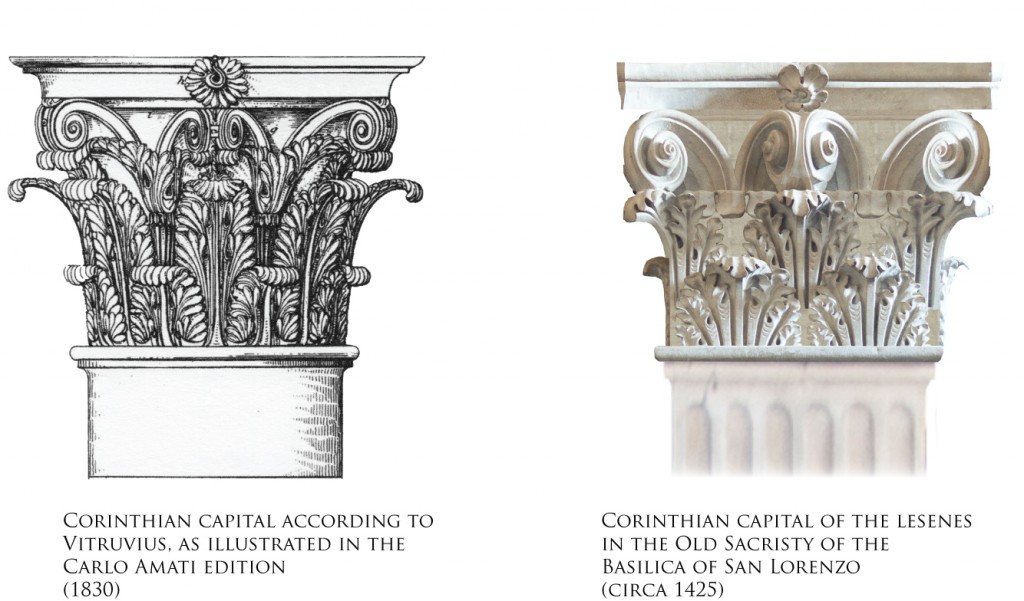
Fig. 6: Comparison of the Corinthian capitals illustrated in the treaty of Vitruvius (Morolli 1988) with the capitals in the Old Sacristy in the Basilica of San Lorenzo
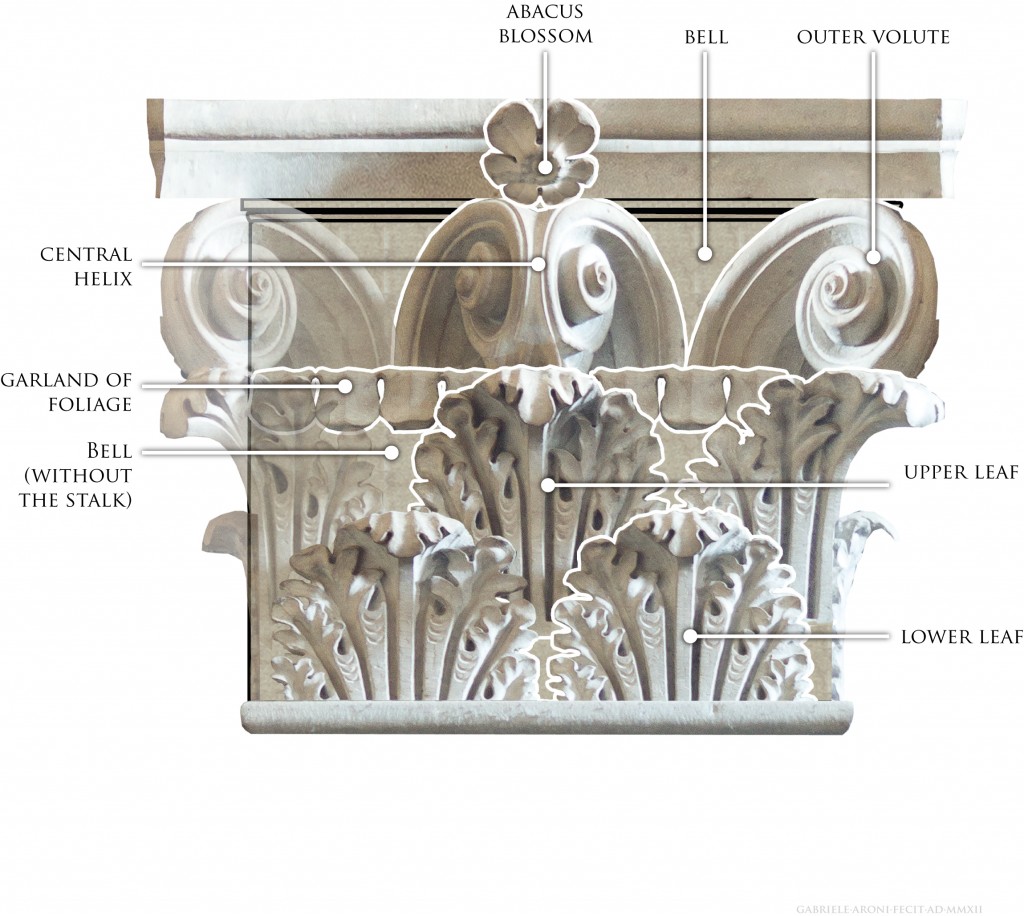
Fig. 7: The Corinthian capital of the lesenes in the Old Sacristy
Meaning
The choice of the Corinthian is intentional and this order was selected for being the most elegant and ornate, (Vitruvius 2003) thus demonstrating a certain availability of money on the commissioner’s end and a will to exalt the glory and prestige of the church. Moreover, the Corinthian order is commonly found in the most prominent Romanesque buildings in Florence, such as the Baptistery of Saint John, a building that Brunelleschi took as a reference in several aspects. The intentions of Brunelleschi were “il tornare a luce la buona architettura” [to bring the good architecture back to light] (Vasari 2005 [1550]: 299), that is the ancient classical one, as opposed to the “todesca e barbara” [German and barbarian] (2005 [1550]: 299) Gothic architecture that was used at the time. Nevertheless, his architecture is imbued with the Gothic and Florentine vernacular heritage as we can notice in several of its aspects. The entablature, despite being divided into the three canonical architrave, frieze and cornice, shows proportional and morphological differences from its classic counterparts: the Vitruvian canon would require an equally tall frieze and architrave with a taller cornice; on the contrary, in the Brunelleschian Corinthian the frieze is the more prominent element, with a similarly tall architrave and a much shorter cornice, around half of the other two members. (fig.5) The same proportions can be observed in Romanesque architecture examples in Florence, such as the Baptistery of Saint John, demonstrating how Brunelleschi turned to the local architecture that in his opinion still had “qualche cosetta di rifresso dello sprendore di quelli antichi edificj di Roma” [some reflections of the splendour of ancient Roman buildings] (Manetti 1976 [1490]) for inspiration. Another possible reason for the reduced dimensions of the cornice might be found in the fact that this is an ‘internal’ order, while the cornice was originally designed with an external function in mind, to act as a gutter, a portion unnecessary in an interior. The capitals as well show a heavy influence from the late-medieval capitals that can be found in Florence, despite maintaining all the essential elements. (fig.6 and 7) The tiers of leaves are reduced from three of the classical Corinthian capital to two; also, their appearance is quite dissimilar from acanthus leaves, resembling instead oak leaves, another heritage from the late-medieval Florentine capitals. Moreover, the oak is a symbol of strength – the Latin word for oak is vis, that also means strength – referring to the strength of the martyr Saint Lawrence, to whom the church is dedicated, and the strength and power of the Medici family. The same meaning can be found in the typical volutes of Brunelleschi’s capitals. Instead of the usual helices, the capitals show eight plastically protruded volutes – called chioccioli, referring to the spirally coiled shells of snails – that resemble the horn of a ram, (Morolli and Ruschi 1993) another symbol of strength and power that reinforces the main meaning of Brunelleschi’s architectural order. Dimensionally speaking the capital is one module tall, as Vitruvius prescribes, but the ratio with the now shorter entablature gives the capital more importance, whereas in antiquity they were considered equally relevant in the architectural order. (Vitruvius 2003)
Significance
The ‘new’ architecture established by Brunelleschi already had a large resonance during the time of the construction of San Lorenzo. As his biographer Manetti reports: “e tirossi su di condizione, che la faceva stupire tutti gli uomini e della città e forestieri, a cui accadeva ‘l vederla, per la sua nuova foggia e bella.” [and it was constructed in a way that stupefied all the people from the city and outside who happened to see it for how new and beautiful it was]. (Manetti 1976 [1490]) This shows the appreciation that not only the experts in the field of art and architecture had of the new church, but also the general interpretant. Brunelleschi’s work echoed into the later Renaissance, where for instance his decision to omit the pedestal, one of the three parts of the classical order, became common use. Brunelleschi’s ‘new’ architecture rapidly became popular, as some of the major Florentine painters of the period celebrated his style by reproducing it in their paintings. The Corinthian capitals that frame the scene in Masaccio’s Holy Trinity are clearly inspired by Brunelleschi, showing all his characteristic trademarks: two tiers of leaves instead of three, very prominent volutes and no blossom stalks. Donatello, a close friend of Brunelleschi, sculpted the same capitals on top of the lesenes in the niche for the statue of Saint Louis of Toulouse on the walls of Orsanmichele. Both works date from the years between 1423 and 1428, showing the immediate popularity that Brunelleschi’s architecture earned. For present-day critics, despite the still ongoing discussion about how much of the San Lorenzo church is actually a product of Brunelleschi (Cohen 2008, 18-57), the style defined there is considered a turning point in western architectural history and the very beginning of the Renaissance.
1440-1460 The Transept and the first three bays
Brunelleschi left the direction of the San Lorenzo construction in 1429, (Morolli and Ruschi 1993) despite that, the work on the new basilica proceeded rapidly under Cosimo dei Medici’s supervision and his son Piero. The architectural order established by Brunelleschi in the Old Sacristy is followed in the rest of the transept and the first three bays with minimal differences.
Sense
Notably, the typical ‘volutes-ram horns’ in the capital lose a twist and generally the marksmanship level is decreased in the sculptural aspect. The capitals are also slightly taller than the ones in the Old Sacristy, (fig.9) not only as regards metrical dimensions, but also most importantly in terms of modules, thus being closer to the proportions that Alberti will later set in his treaty, and that can be found in late imperial Roman ruins. The frieze of the entablature in the transept and over the lesenes of the aisles is a uniform and continuous white surface, unlike the classical decorated one and the frieze in the Old Sacristy – even though the latter was decorated by Donatello only around 1430, most likely changing Brunelleschi’s original design – while the rest of the entablature is made of grey sandstone. (fig.8) The entablature of the columns in the nave is instead entirely of grey sandstone, but shows a sculpturally decorated frieze. (fig.10)
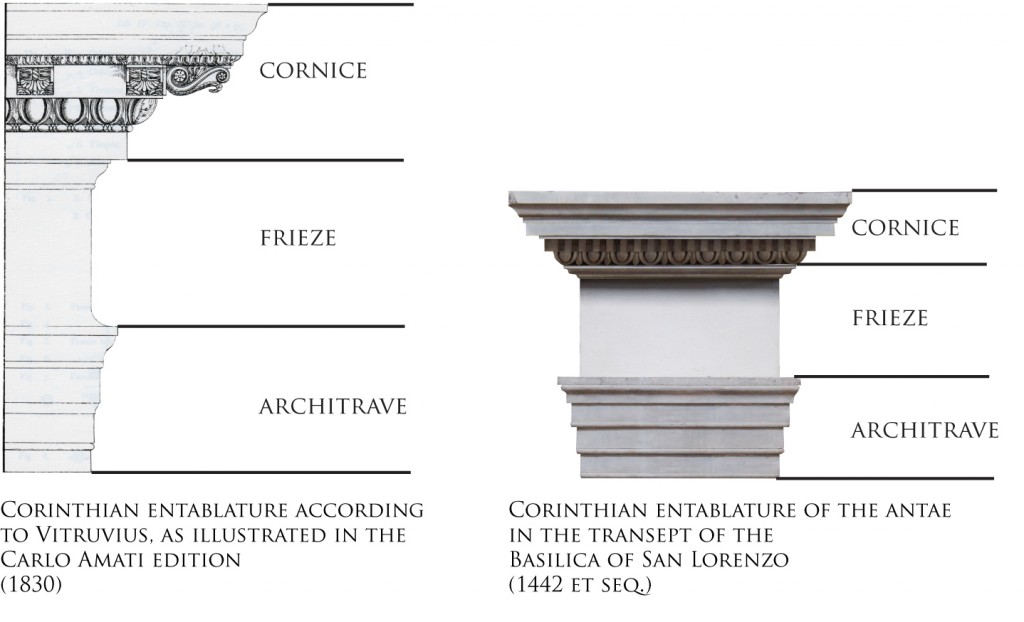
Fig. 8: Comparison of the Corinthian entablature illustrated in the treaty of Vitruvius (Morolli 1988) with the entablature in the transept of the Basilica of San Lorenzo
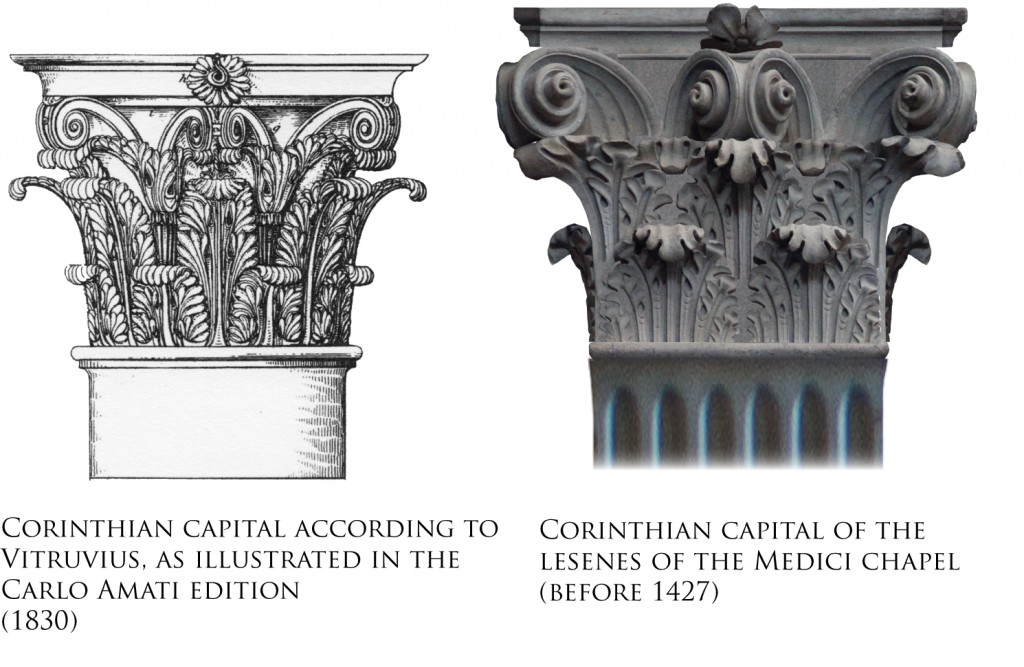
Fig. 9: Comparison of the Corinthian capital illustrated in the treaty of Vitruvius (Morolli 1988) with the Corinthian capital of the lesenes in the Medici Chapel in the Basilica of San Lorenzo
Fig. 10: Comparison of the Corinthian entablature illustrated in the treaty of Vitruvius (Morolli 1988) with the entablature of the Corinthian order in the nave of the Basilica of San Lorenzo
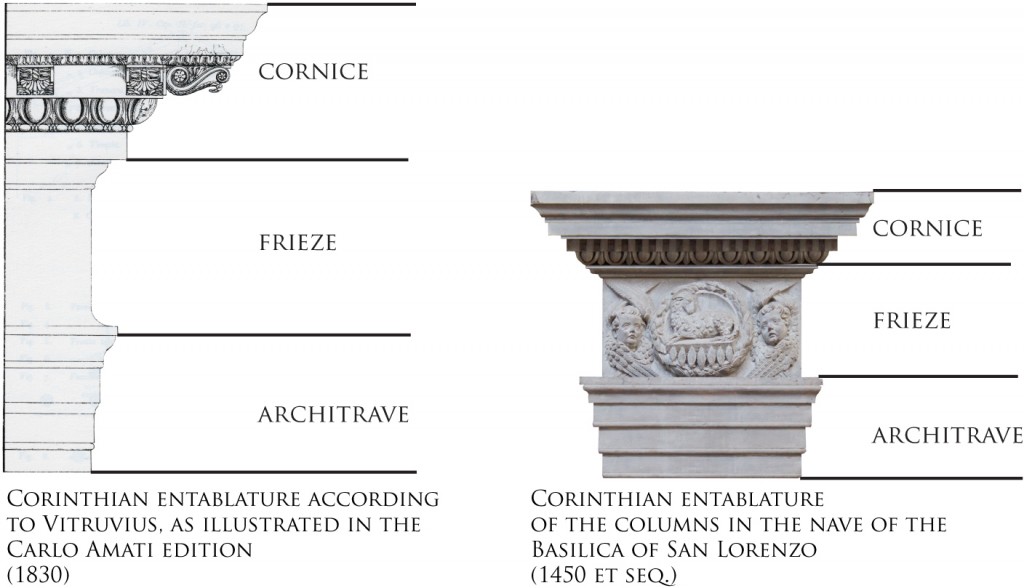
Meaning
This detachment from the Vitruvian canon can be due to the fact that the capitals are placed on a much higher ground, thus needing an optical correction not to appear too small to the viewer on the ground level. The entablature is slightly shorter than the one in the Old Sacristy, giving even more importance to the capital. This confirms how, for this first generation of classicists-humanists, the capital was the most prominent part of the architectural order-unlike in classical times, when the entablature played an equally important role-thus becoming the symbol of the new era of architecture. The iconographic program is the same as the one established by Brunelleschi in the Old Sacristy, with the oak leaves and the ram horns in the capitals as symbols of strength and reminders of the Florentine medieval tradition. The white continuous frieze of the entablature in the transept and in the aisles is to emphasize the conceptual meaning of the entablature and not its structural function. (Morolli and Ruschi 1993) The sculptural decoration of the frieze in the central nave is again a closer match to the classical Corinthian than the plain white Brunelleschi designed.
Significance
As the stylistic differences are minimal and the iconographic program is the same, semiotically speaking, the Significance does not differ from what was asserted for 1422-1428, except in how the first three rows of columns were received by the interpretants of the time. Both Manetti and Vasari consider that there are “errors” (Vasari 2005 [1550]) and “several inconveniences” in these first three bays, thus indicating a certain dissatisfaction with the departure from Brunelleschi’s style. (Manetti 1976 [1490])
1465-1480 The last four bays
In 1464 Cosimo dei Medici dies, leaving the direction of the construction of San Lorenzo to his son Piero who will be succeeded by Lorenzo dei Medici in 1469. More than forty years have gone by since Brunelleschi first intervened on the church (he passed away in 1446) and the cultural climate and architectural taste in Florence changed. The De Re Aedificatoria of Leon Battista Alberti was already circulating and greatly influenced how the architectural order was conceived. In 1465 the remaining four pairs of columns are put into place, (Morolli and Ruschi 1993) with substantial differences compared to the previous ones, as we will see further on.
Sense
The order is still the Corinthian, with the same proportions established in the first three rows of columns. The capitals maintain the same height set by Brunelleschi in the Medici Chapel, but the elements are closer to the classical Corinthian than the Brunelleschi ones. (fig.11) The stalks are present – they were omitted in the Brunelleschi version of the Corinthian – but the blossom stalk is substituted once again by the garland of foliage between the leaves and the volutes. The volutes are also flatter, with one less twist and a small leaf is added on the top. (fig.12) The leaves are notably transformed both in sculptural terms and in their details, numbering five instead of seven lobes. All these changes are more and more accentuated as one goes down the nave towards the façade: the garland of foliage completely disappears and is substituted by a more classical stalk bud.
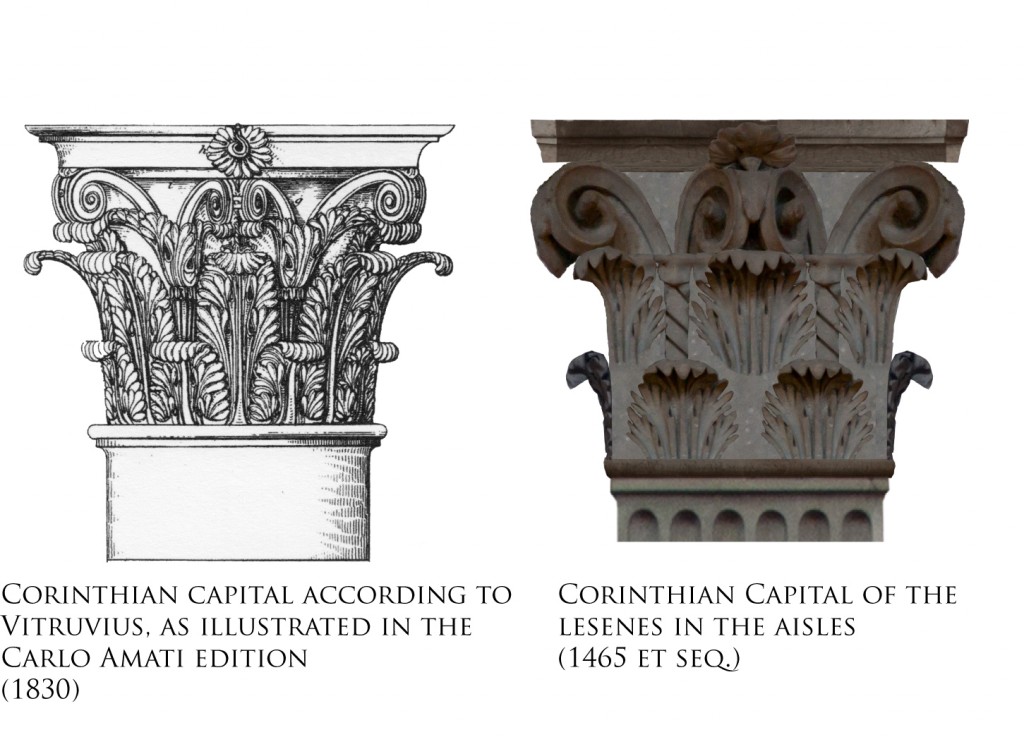
Fig. 11: Comparison of the Corinthian capital illustrated in the treaty of Vitruvius (Morolli 1988) with the capital of the lesenes in the aisles in the Basilica of San Lorenzo
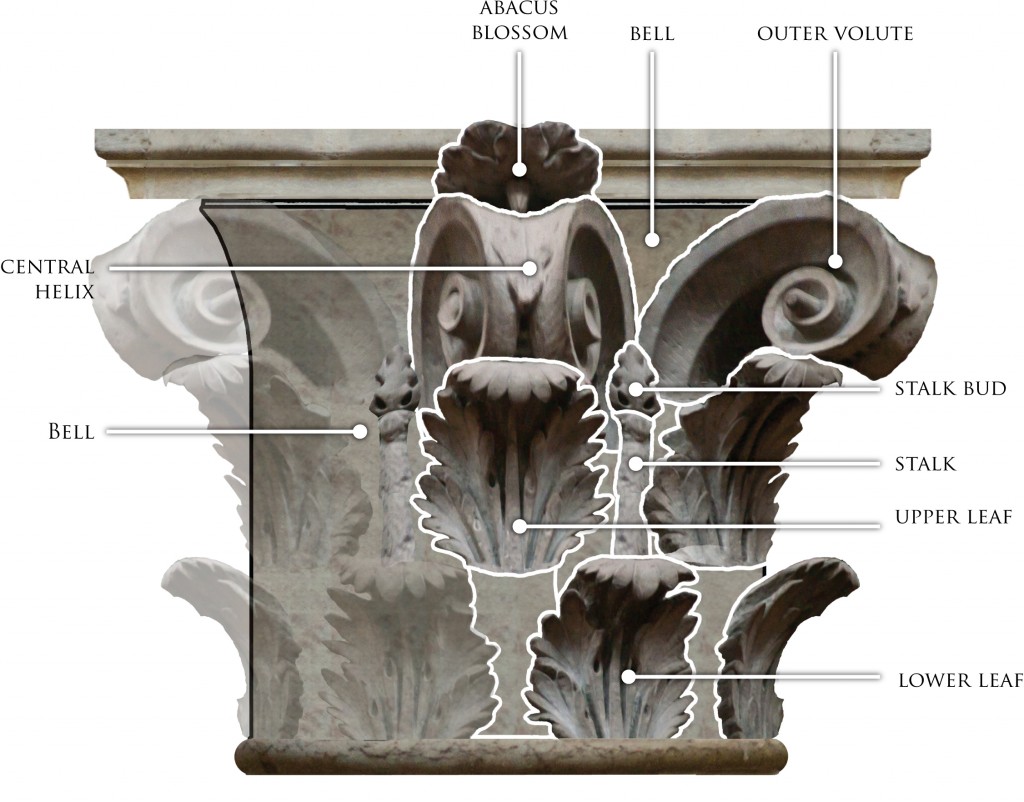
Fig. 12: Corinthian Capital of one of the columns constructed during the supervision of Lorenzo dei Medici
Meaning
The changes visible in the columns created between 1465 and 1480 – thus in the part of the church first built under the supervision of Piero dei Medici and then under Lorenzo dei Medici from 1469 onwards – (Morolli and Ruschi 1993) are the product of a changed architectural taste, that expected a more classically correct capital, modelled on the late imperial Roman ruins and coded in Alberti’s treaty De Re Aedificatoria. Piero dei Medici was an admirer of Alberti’s work and the style of the part of San Lorenzo built under his supervision thus reflects his taste. The general proportions and members of the architectural orders were already put into place by his predecessors and were followed in order to avoid major discrepancies; however, this did not prevent the stonemasons from operating significant changes to the morphology of the capitals and the new iconographic program of the Medici. So as not to vary too much from Brunelleschi’s capitals, but at the same time to steer towards a new, more ‘antique’ style, the elements are the same: just two tiers of leaves instead of three, eight volutes and a garland of foliage. However, the stalks are added, in order to have a more classically ‘correct’ capital, and the volutes are flatter and less protruded, so as to have an aspect more similar to the classical helices, and not the ram horns of the medieval and Brunelleschian capitals. The leaves are also deeply modified, firstly in order to save time – and thus money – on the creation of the capitals: the lobes number five instead of seven and the sculpture is generally less detailed. At the same time, the aspect of the leaves is more similar to the original, classical Corinthian acanthus than to the medieval oak, resembling olive tree leaves. The olive leaves were an essence often used in the classical Corinthian capitals, as a tree sacred to Zeus and a symbol of peace. This was a symbol particularly dear to Lorenzo dei Medici, as it was used to manifest his pacific political program together with his architectural ‘contemporary’ taste. Moving towards the façade, the capitals become more and more similar to the classical ones: the volutes resemble the canonical helices and the garland of leaves disappears, replaced by the classically ‘correct’ stalk and stalk bud. (fig.12)
Significance
Some of the most eminent artists of the time expressed perplexity over the change in style that the ‘new’ San Lorenzo took after Brunelleschi and Cosimo dei Medici’s direction. Luca della Robbia “se ne doleva” [was saddened] (Manetti 1976 [1490]) and both Manetti and Vasari complained about how the church was completed, underlying that heavy modifications were put into place compared to Brunelleschi’s original project. Nevertheless, Manetti himself admits that the church was a “bella cosa” [beautiful thing] (1976 [1490]), and is more preoccupied about clarifying that not all of it is Brunelleschi’s work than criticizing the architectural choices. Despite indications that the overall proportional framework might actually have been conceived by Brunelleschi himself – if not by Matteo Dolfini, his predecessor as capomastro of San Lorenzo – (Cohen 2008, 18-57) the drastic switch in the interpretation of the classical order in the last part of the church leads to presume that the echo of Brunelleschi’s original plan, a ‘new’ architectural order, merging the vernacular Florentine tradition and the newly rediscovered antique tradition, faded in the following decades.
Conclusion
This analysis of the semiotics of the architectural order has made it possible to track and investigate the major stylistic, symbolic and historical changes that took place during the construction of the Basilica. (fig.13) It is argued that considering these changes without their semantic aspect would deprive the analysis of a fundamental component that helps historians of architecture to understand why and how such changes occurred. San Lorenzo is often mentioned as the first truly Renaissance church ever built (Wittkower 1953, 275-291) despite its tumultuous construction history. Filippo Brunelleschi is directly linked to the overall aspect of the church, yet while his design inevitably influenced those who came after him, it is important to not mistakenly attribute all of the church to him, for as Manetti wrote, addressing the reader: “ma io conforto te, quando tu hai tempo, a rileggerle, o a notarle bene, perché elle sono di grande importanza, e stimandosi di Filippo si stimerebbe ‘l falso, e non è punto drento l’onore suo.” [I advise you, when you have the time, to read them again or notice them [the changes in the nave] well, because they are of great importance, and to consider them a work of Brunelleschi would be wrong, and there is none of his honour in it.] (Manetti 1976 [1490])
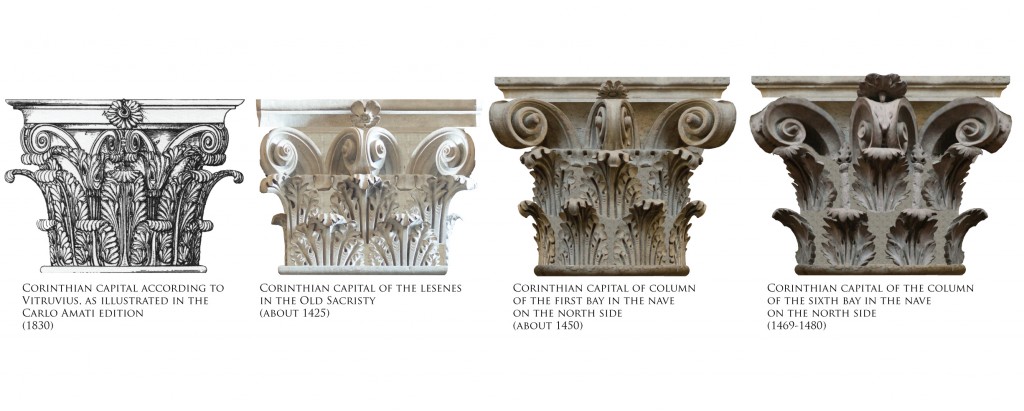
Fig. 13: Starting from the left: the Corinthian capital according to Vitruvio (Morolli 1988), one from the Old Sacristy by Brunelleschi, one from the columns of the first three bays, and one from the lesenes in the rectangular chapels of the aisles in the last four bays
Acknowledgments
All the photographs were taken and elaborated by the author except where otherwise stated.
I would like to thank Prof. Gabriele Morolli for his invaluable inspiration, and the Opera Medicea Laurenziana, in particular Rag. Giuseppe Caruso, for allowing me to conduct the survey inside the Basilica of San Lorenzo.
Bibliography
Bruschi, Arnaldo and Gaetano Miarelli Mariani. 1980. “Fonti Del Linguaggio Brunelleschiano.” In Filippo Brunelleschi La Sua Opera Il Suo Tempo, edited by Franco Borsi, 389-415. Florence: Centro Di.
Cohen, Matthew A. 2008. “How Much Brunelleschi? A Late Medieval Proportional System in the Basilica of San Lorenzo in Florence.” Journal of the Society of Architectural Historians 67 (1): 18-57.
Eco, Umberto. 1997. “Function and Sign: The Semiotics of Architecture.” In Rethinking Architecture : A Reader in Cultural Theory, edited by Neil Leach, 173-195. Florence, KY, USA: Routledge.
Morolli, Gabriele. 1988. L’Architettura Di Vitruvio Nella Versione Di Carlo Amati (1829-1830). Florence: Alinea.
Munro, C. F. 1987. “Semiotics, Aesthetics and Architecture.” The British Journal of Aesthetics 27 (2): 115-128.
Norberg-Schulz, Christian. 1968. Intentions in Architecture. Cambridge, Mass.: M.I.T. Press.
Petrilli, Susan. 2009. Signifying and Understanding: Reading the Works of Victoria Welby and the Signific Movement, edited by Victoria Welby. Berlin: Mouton de Gruyter.
Vasari, Giorgio. 2005 [1550]. Le Vite De’ Più Eccellenti Architetti, Pittori, Et Scultori Italiani, Da Cimabue, Insino a’ Tempi Nostri. Florence: Einaudi.
Vitruvius, Pollio. 2003. Vitruvius on Architecture, edited by Thomas Gordon Smith. New York: Monacelli Press.
Wallis, Mieczyslaw. 1973. “Semantic and Symbolic Elements in Architecture: Iconology as a First Step Towards an Architectural Semiotic.” Semiotica 8 (3): 220-238.
Wittkower, R. 1953. “Brunelleschi and ‘Proportion in Perspective’.” Journal of the Warburg and Courtauld Institutes 16 (3/4): 275-291.
Wittkower, Rudolf. 1988. Architectural Principles in the Age of Humanism. London; New York: Academy Editions; St. Martin’s Press.